Sacred
Places --Hallowed Ground
Abbeystrowry
Cemetery, Skibereen Co. Cork
Site of Burial Pits and mass graves of the Great Hunger 1845 -
1850

The so named burial pits
is where approximately 9,000 men, women and children were buried,
coffin-less, oftentimes in the dead of night during the during The
Great Hunger years of 1845-1852. The graveyard is
adjacent to what was once the Skibereen Workhouse where many of
those who are buried in the pits came from. The workhouse
was the last resort for the victims of indifference and disease
who sought shelter and food. What they found
was inhumanity, disease and death.
The workhouse which opened
in March
of 1842 was designed to house eight hundred people considered
to be the dregs of society by the elites. By the height of the
Great Hunger in December 1848, 4,230 poor souls
are recorded as residing there.
Click
Here for details
Viniger
Hill, Eniscorthy, Co. Wexford
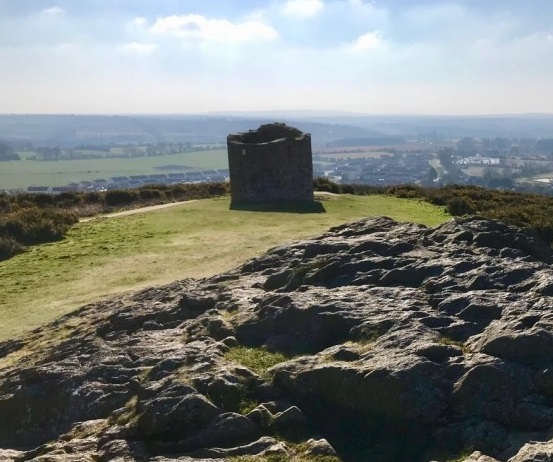
Requiem for
the Croppies
Seamus
Heaney
The pockets of our greatcoats full of barley...
No kitchens on the run, no striking camp...
We moved quick and sudden in our own country.
The priest lay behind ditches with the tramp.
A people hardly marching... on the hike...
We found new tactics happening each day:
We'd cut through reins and rider with the pike
And stampede cattle into infantry,
Then retreat through hedges where cavalry must be thrown.
Until... on Vinegar Hill... the final conclave.
Terraced thousands died, shaking scythes at cannon.
The hillside blushed, soaked in our broken wave.
They buried us without shroud or coffin
And in August... the barley grew up out of our grave
"Requiem for the
Croppies" is based on the battle of Vinegar Hill. Over
10,000 Irish rebels and their families were massacred, and many
bodies were desecrated, including that of a priest.
The Battle of Vinegar Hill, Irish
Chnoc Fíodh na gCaor was an engagement during the
Irish Rebellion of 1798
on 21 June 1798 when over 15,000 British soldiers launched
an attack on Vinegar Hill outside
Enniscorthy, County Wexford, the largest camp and
headquarters of the Wexford
United Irish rebels. It marked a turning point in the
rebellion, as it was the last attempt by the rebels to hold
and defend ground against the British military. The battle
was actually fought in two locations: on Vinegar Hill itself
and in the streets of nearby Enniscorthy
Click on the link below for details.
https://military-history.fandom.com/wiki/Battle_of_Vinegar_Hill
Croppies Acre
D.
F. Moore, ‘Croppies Acre’, in The Irish Times ([June]
1967):
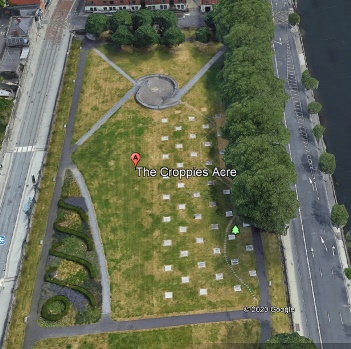 The
Rising of 1798 was marked by the severest repression and the
greatest barbarity that the Irish nation had ever experienced.
In the vicinity of Dublin, yeomen and military hunted
mercilessly for participants, and in their lust for blood, cared
little for their victims’ guilt or and less for justice.
The
Rising of 1798 was marked by the severest repression and the
greatest barbarity that the Irish nation had ever experienced.
In the vicinity of Dublin, yeomen and military hunted
mercilessly for participants, and in their lust for blood, cared
little for their victims’ guilt or and less for justice.
Information on the. atrocities committed is not confined to
prejudiced or traditional accounts, for Lord Cornwallis, in his
correspondence, bluntly stated that any man in a brown coat
found within several miles of the field of action was butchere
without discrimination.
The mutilated remains, piled high in carts, were paraded
through the city streets and laid out in the yard of Dublin
Castle, while prisoners were executed without trail, frequently
being hung from lamp posts in the public thoroughfare. A piece
of waste ground close to the river was utilised the speedy
disposal of their bodies, and into hurriedly dug trenches in
this slobland were tossed the pathetic remains of the victims of
the terror.
Among those consigned to this rude plot, known to sueceding
generations as the Croppies Acre, were the brother of Sir Thomas
Esmonde, Dr. Esmonde, who was hanged on Carlisle Bridge;
Bartholomew Teeling, who sailed with Humbert’s expedition from
France and was executed at Arbour Hill; Ledwich, brother of the
Parish Prieset of Rathfarnham, who was hanged on Queen Street
Bridge; Wade, Fox, Raymond, Bacon, Kelly, Byrne, Adam and
Carroll all of whom were publicly hanged in different parts of
the city.
Croppies’ Acre lies on the side of the river in front of
Collins Barracks. It extends from a point midway between the
between the barracks boundary wall, and Wolfe Tone Quay,
eastwards and down to the water, for in 1798 the Liffey had yet
to be embanked and the waste plot bordered the river.
“The day will come”, wrote Dr. Madden the historian of the
United Irishmen, over one hundred years ago, “when that
desecrated spot will be hallowed ground … decorated by funeral
trophies in honour of the dead whose bones lie there in graves
that are now neglected and unhonoured.” The day has indeed been
long in coming.
Grosse Ile,
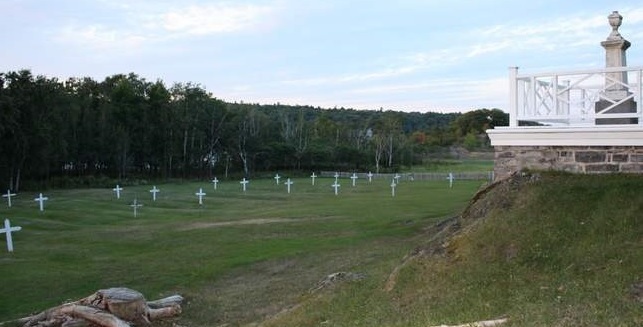 Grosse
Ile, isolated in mid-river but still close to Quebec City,
opened as a quarantine station in 1832, in response to
Canadian fears of the cholera epidemic in Europe. The
failures of the quarantine station are measured in the
burial sites of thousands of Irish immigrants, on the island
and down the length of the St. Lawrence as far west as
Hamilton.
Grosse
Ile, isolated in mid-river but still close to Quebec City,
opened as a quarantine station in 1832, in response to
Canadian fears of the cholera epidemic in Europe. The
failures of the quarantine station are measured in the
burial sites of thousands of Irish immigrants, on the island
and down the length of the St. Lawrence as far west as
Hamilton.
They died of cholera in 1832—and of typhus, ship
fever and starvation while fleeing from the Great Hunger in
the 1840s. At the western end of the island, between Cholera
Bay and the Celtic cross on Telegraph Hill, is a long
meadow, corrugated by a regular series of ridges, which
inevitably remind the visitor of lazy beds, ridge-and-trench
potato fields. On Grosse Ile, too, the ridges are man-made,
for they mark the mass graves where the Irish famine victims
of 1847 were buried, ‘stacked like cordwood’.
The Grosse Ile Tragedy
(irishhistorian.com)
Kilmainham Execution
Yard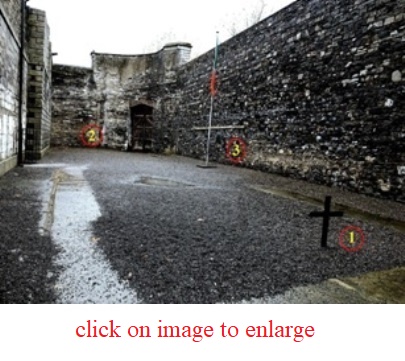
Kilmainham
Jail was built in 1796 and for the following 128 years was the place
where many of Irelands revolutionary leaders were incarcerated
and/or executed by the occupying British. It was where Robert
Emmet was held before he was hanged drawn and quartered and where
his housekeeper Ann Devlin was imprisoned and tortured for not
informing on Emmet's collaborators.
The
leaders of the 1916 Easter Rising, were executed by the
British occupiers in the prison yard at the marker locations
shown above.
On May 3 through May 12, 1916
at marker location 1, the following leaders were
executed by
firing squad--- Patrick Pearse, Thomas Clarke, Thomas MacDonagh,
Joseph Plunkett, Edward Daly, Michael O'Hanrahan, Willie
Pearse, John MacBride, Éamonn Ceannt, Michael Mallin,
Seán Heuston, Con Colbert and Sean MacDiarmada
On May 12 at marker
location
2,
James Connolly was executed by firing squad while strapped to a chair.
On November 17,
1922 at marker location 3, the British supported Irish Free
State executed Peter Cassidy, James Fisher, John Gaffney
and Richard Twohig by firing squad.
In all, the
Irish Free State summarily executed 77 Republican fighters
during the Treaty (Civil) War.
The prison was
closed in 1924. It was turned into a museum in
1980
Arbour Hill Cemetery --- Burial place of the leaders of the
1916 Rising
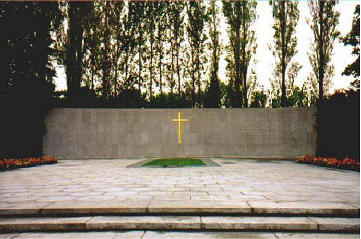
The military cemetery at Arbour
Hill is the last resting place of 14 of the executed leaders
of the 1916 Easter Rising. The burial plot includes the
remains of Thomas J. Clarke, James Connolly, Patrick Pearse,
Thomas MacDonagh, Sean MacDiarmada, Eamonn Ceannt, Joseph M.
Plunkett, Edward Daly, Con Colbert, Michael O'Hanrahan, Sean
Heuston, John MacBride, William Pearse and Michael Mallin.
The leaders were executed in Kilmainham and then their
bodies were buried in Arbour Hill.
The other two leaders executed are:
Thomas Kent who was executed in Cork Army Barracks and
buried next to his execution spot. His remains were
removed in 2015 and re-interned in the family burial plot in
Castlelyons
Cemetery near Fermoy in Co. Cork.
Roger Casement was hanged in Pentonville prison in London on
the 3rd. of August, 1916. His body was disposed of,
coffinless, in a quicklime pit.
The quicklime, they said, would consume the flesh
and leave the white bones—the skeleton—intact,
which could then be moved easily. -- Oscar
Wilde,
His remains were returned to Ireland in 1965 and now rest
in Glasnevin Cemetery, Dublin.
Republican Plot, Glasnevin Cemetery, Dublin
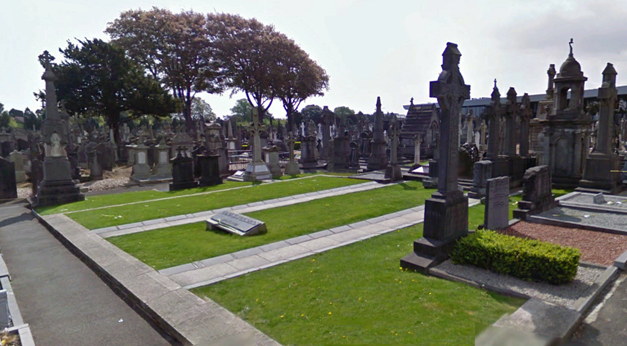 The
Republican plot contains the remains of individuals involved
in the 1803, 1848, 1867 Uprisings and in the War of
Independence and the Treaty (Civil) War and other Irish
Republicans post 1923.
The
Republican plot contains the remains of individuals involved
in the 1803, 1848, 1867 Uprisings and in the War of
Independence and the Treaty (Civil) War and other Irish
Republicans post 1923.
The following historical
figures constitute a fraction of the many others interred in
the Republican Plot
Anne Devlin, Thomas Bellew
McManus, O'Donovan Rossa, John O'Mahony, Countess Markieviez,
Margaret Skinnider, Roger Casement, Cathal Brugha, Ernest
Bernard O'Malley, Harry Boland and Daithi O'Conaill.
Commemorations are held there
by various Republican groups and political parties to
commemorate the 1916 Easter Rising and the anniversaries of
the deaths of some of those buried there.
Glasnevin
Cemetery remains under the care of the Dublin Cemeteries
Committee